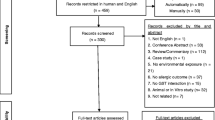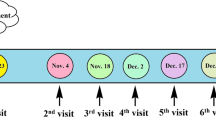Abstract
Purpose of Review
The purpose of this review is to summarize the evidence from recently published original studies investigating how glutathione S-transferase (GST) gene polymorphisms modify the impact of air pollution on asthma, allergic diseases, and lung function.
Recent Findings
Current studies in epidemiological and controlled human experiments found evidence to suggest that GSTs modify the impact of air pollution exposure on respiratory diseases and allergies. Of the nine articles included in this review, all except one identified at least one significant interaction with at least one of glutathione S-transferase pi 1 (GSTP1), glutathione S-transferase mu 1 (GSTM1), or glutathione S-transferase theta 1 (GSTT1) genes and air pollution exposure. The findings of these studies, however, are markedly different. This difference can be partially explained by regional variation in the exposure levels and oxidative potential of different pollutants and by other interactions involving a number of unaccounted environment exposures and multiple genes.
Summary
Although there is evidence of an interaction between GST genes and air pollution exposure for the risk of respiratory disease and allergies, results are not concordant. Further investigations are needed to explore the reasons behind the discordancy.
Similar content being viewed by others
References
Papers of particular interest, published recently, have been highlighted as: • Of importance •• Of major importance
Xing Y-F, Xu Y-H, Shi M-H, Lian Y-X. The impact of PM2.5 on the human respiratory system. J Thorac Dis. 2016;8(1):E69–74. doi:10.3978/j.issn.2072-1439.2016.01.19.
Last JA, Sun WM, Witschi H. Ozone, NO, and NO2: oxidant air pollutants and more. Environ Health Perspect. 1994;102 Suppl 10:179–84.
Nawrot TS, Kuenzli N, Sunyer J, Shi T, Moreno T, Viana M, et al. Oxidative properties of ambient PM2.5 and elemental composition: heterogeneous associations in 19 European cities. Atmos Environ. 2009;43(30):4595–602. doi:10.1016/j.atmosenv.2009.06.010.
Velsor LW, Postlethwait EM. NO2-induced generation of extracellular reactive oxygen is mediated by epithelial lining layer antioxidants. Am J Physiol. 1997;273(6 Pt 1):L1265–75.
•• Carlsten C, Blomberg A, Pui M, Sandstrom T, Wong SW, Alexis N, et al. Diesel exhaust augments allergen-induced lower airway inflammation in allergic individuals: a controlled human exposure study. Thorax. 2016;71(1):35–44. doi:10.1136/thoraxjnl-2015-207399. This controlled human exposure study demonstrated that exposure to diesel exhaust augments allergen-induced lower airway inflammation in allergic individuals with GSTT1 null polymorphism.
Olivieri D, Scoditti E. Impact of environmental factors on lung defences. Eur Respir Rev. 2005;14(95):51–6.
Gilliland FD, Li Y-F, Saxon A, Diaz-Sanchez D. Effect of glutathione-S-transferase M1 and P1 genotypes on xenobiotic enhancement of allergic responses: randomised, placebo-controlled crossover study. Lancet. 2004;363(9403):119–25. doi:10.1016/S0140-6736(03)15262-2.
Chen E, Schreier HM, Strunk RC, Brauer M. Chronic traffic-related air pollution and stress interact to predict biologic and clinical outcomes in asthma. Environ Health Perspect. 2008;116(7):970–5. doi:10.1289/ehp.11076.
Gordian ME, Haneuse S, Wakefield J. An investigation of the association between traffic exposure and the diagnosis of asthma in children. J Expo Sci Environ Epidemiol. 2006;16(1):49–55. doi:10.1038/sj.jea.7500436.
Sienra-Monge JJ, Ramirez-Aguilar M, Moreno-Macias H, Reyes-Ruiz NI, Del Rio-Navarro BE, Ruiz-Navarro MX, et al. Antioxidant supplementation and nasal inflammatory responses among young asthmatics exposed to high levels of ozone. Clin Exp Immunol. 2004;138(2):317–22. doi:10.1111/j.1365-2249.2004.02606.x.
Allen RG, Tresini M. Oxidative stress and gene regulation. Free Radic Biol Med. 2000;28(3):463–99. doi:10.1016/S0891-5849(99)00242-7.
Weiss ST. Lung function and airway diseases. Nat Genet. 2010;42(1):14–6.
Strange RC, Spiteri MA, Ramachandran S, Fryer AA. Glutathione-S-transferase family of enzymes. Mutat Res. 2001;482(1–2):21–6. doi:10.1016/S0027-5107(01)00206-8.
Hayes JD, Strange RC. Glutathione S-transferase polymorphisms and their biological consequences. Pharmacology. 2000;61(3):154–66. doi:10.1159/000028396.
Piacentini S, Polimanti R, Simonelli I, Donno S, Pasqualetti P, Manfellotto D, et al. Glutathione S-transferase polymorphisms, asthma susceptibility and confounding variables: a meta-analysis. Mol Biol Rep. 2013;40(4):3299–313. doi:10.1007/s11033-012-2405-2.
Romieu I, Moreno-Macias H, London SJ. Gene by environment interaction and ambient air pollution. Proc Am Thorac Soc. 2010;7(2):116–22. doi:10.1513/pats.200909-097RM.
Holloway JW, Savarimuthu Francis S, Fong KM, Yang IA. Genomics and the respiratory effects of air pollution exposure. Respirology. 2012;17(4):590–600. doi:10.1111/j.1440-1843.2012.02164.x.
Hosgood Iii HD, Berndt SI, Lan Q. GST genotypes and lung cancer susceptibility in Asian populations with indoor air pollution exposures: A meta-analysis. Mutat Res. 2007;636(1–3):134–43. doi:10.1016/j.mrrev.2007.02.002.
•• Minelli C, Wei I, Sagoo G, Jarvis D, Shaheen S, Burney P. Interactive effects of antioxidant genes and air pollution on respiratory function and airway disease: a HuGE review. Am J Epidemiol. 2011;173(6):603–20. doi:10.1093/aje/kwq403. Systematic review that synthesized evidence based on literature published until 2009 related to interactions of oxidative stress gene polymorphisms on air pollution exposure and airway diseases.
Kellen E, Hemelt M, Broberg K, Golka K, Kristensen VN, Hung RJ, et al. Pooled analysis and meta-analysis of the glutathione S-transferase P1 Ile 105Val polymorphism and bladder cancer: a HuGE-GSEC review. Am J Epidemiol. 2007;165(11):1221–30. doi:10.1093/aje/kwm003.
•• Curjuric I, Imboden M, Schindler C, Downs SH, Hersberger M, Liu SLJ, et al. HMOX1 and GST variants modify attenuation of FEF25-75% decline due to PM10 reduction. Eur Respir J. 2009;35(3):505–14. doi:10.1183/09031936.000443-2009. Using data from a longitudinal cohort, this study demonstrated the effects of reduced PM 10 over 11 years on lung function change in relation to GST polymorphisms.
Fuertes E, Brauer M, MacIntyre E, Bauer M, Bellander T, von Berg A, et al. Childhood allergic rhinitis, traffic-related air pollution, and variability in the GSTP1, TNF, TLR2, and TLR4 genes: results from the TAG Study. J Allergy Clin Immunol. 2013;132(2):342-52.e2. doi:10.1016/j.jaci.2013.03.007.
•• MacIntyre EA, Brauer M, Melen E, Bauer CP, Bauer M, Berdel D, et al. GSTP1 and TNF Gene variants and associations between air pollution and incident childhood asthma: the traffic, asthma and genetics (TAG) study. Environ Health Perspect. 2014;122(4):418–24. doi:10.1289/ehp.1307459. Combining six birth cohort studies and using advanced air pollution modeling, this study demonstrated how early life exposure to air pollutants is modified by GST polymorphisms.
Hwang B-F, Young L-H, Tsai C-H, Tung K-Y, Wang P-C, Su M-W, et al. Fine particle, ozone exposure, and asthma/wheezing: effect modification by glutathione S-transferase P1 polymorphisms. PLoS One. 2013;8(1):e52715. doi:10.1371/journal.pone.0052715.
• Su MW, Tsai CH, Tung KY, Hwang BF, Liang PH, Chiang BL, et al. GSTP1 is a hub gene for gene-air pollution interactions on childhood asthma. Allergy. 2013;68(12):1614–7. doi:10.1111/all.12298. This study reported the effects of differential exposure levels of PM 10 on childhood asthma in children with GSTP1 polymorphism.
Bowatte G, Lodge CJ, Knibbs LD, Lowe AJ, Erbas B, Dennekamp M, et al. Traffic-related air pollution exposure is associated with allergic sensitization, asthma, and poor lung function in middle age. J Allergy Clin Immunol. 2016. doi:10.1016/j.jaci.2016.05.008.
Chen B-Y, Chen C-H, Chuang Y-C, Kim H, Honda Y, Chiang H-C, et al. Schoolchildren’s antioxidation genotypes are susceptible factors for reduced lung function and airway inflammation caused by air pollution. Environ Res. 2016;149:145–50. doi:10.1016/j.envres.2016.05.007.
Reddy P, Naidoo RN, Robins TG, Mentz G, Li H, London SJ, et al. GSTM1 and GSTP1 gene variants and the effect of air pollutants on lung function measures in South African children. Am J Ind Med. 2012;55(12):1078–86. doi:10.1002/ajim.22012.
• Bowatte G, Lodge CJ, Lowe AJ, Erbas B, Dennekamp M, Marks GB, et al. Do variants in GSTs modify the association between traffic air pollution and asthma in adolescence? Int J Mol Sci. 2016;17(4):485. doi:10.3390/ijms17040485. First epidemiological study to report the significant effects of GSTT1 polymorphisms for the association of air pollution exposure and asthma/wheeze.
MacIntyre EA, Carlsten C, MacNutt M, Fuertes E, Melen E, Tiesler CMT, et al. Traffic, asthma and genetics: combining international birth cohort data to examine genetics as a mediator of traffic-related air pollution’s impact on childhood asthma. Eur J Epidemiol. 2013;28(7):597–606. doi:10.1007/s10654-013-9828-5.
Mainwaring GW, Williams SM, Foster JR, Tugwood J, Green T. The distribution of theta-class glutathione S-transferases in the liver and lung of mouse, rat and human. Biochem J. 1996;318(Pt 1):297–303.
Raimondi S, Paracchini V, Autrup H, Barros-Dios JM, Benhamou S, Boffetta P, et al. Meta- and pooled analysis of GSTT1 and lung cancer: a HuGE-GSEC review. Am J Epidemiol. 2006;164(11):1027–42. doi:10.1093/aje/kwj321.
Yang F, Xiong J, Jia X-E, Gu Z-H, Shi J-Y, Zhao Y, et al. GSTT1 deletion is related to polycyclic aromatic hydrocarbons-induced DNA damage and lymphoma progression. PLoS One. 2014;9(2):e89302. doi:10.1371/journal.pone.0089302.
Zhang X, Hirota JA, Yang C, Carlsten C. Effect of GST variants on lung function following diesel exhaust and allergen co-exposure in a controlled human crossover study. Free Radic Biol Med. 2016;96:385–91. doi:10.1016/j.freeradbiomed.2016.04.202.
Madden MC, Stevens T, Case M, Schmitt M, Diaz-Sanchez D, Bassett M, et al. Diesel exhaust modulates ozone-induced lung function decrements in healthy human volunteers. Part Fibre Toxicol. 2014;11(1):1–10. doi:10.1186/s12989-014-0037-5.
Calderón-Garcidueñas L, Rodríguez-Alcaraz A, Villarreal-Calderón A, Lyght O, Janszen D, Morgan KT. Nasal epithelium as a sentinel for airborne environmental pollution. Toxicol Sci. 1998;46(2):352–64. doi:10.1093/toxsci/46.2.352.
Shusterman D. The effects of air pollutants and irritants on the upper airway. Proc Am Thorac Soc. 2011;8(1):101–5. doi:10.1513/pats.201003-027RN.
Gowers AM, Cullinan P, Ayres JG, Anderson HR, Strachan DP, Holgate ST, et al. Does outdoor air pollution induce new cases of asthma? Biological plausibility and evidence; a review. Respirology. 2012;17(6):887–98. doi:10.1111/j.1440-1843.2012.02195.x.
Guarnieri M, Balmes JR. Outdoor air pollution and asthma. Lancet. 2014;383(9928):1581–92. doi:10.1016/s0140-6736(14)60617-6.
Huang SK, Zhang Q, Qiu Z, Chung KF. Mechanistic impact of outdoor air pollution on asthma and allergic diseases. J Thorac Dis. 2015;7(1):23–33. doi:10.3978/j.issn.2072-1439.2014.12.13.
Bowler RP, Crapo JD. Oxidative stress in allergic respiratory diseases. J Allergy Clin Immunol. 2002;110(3):349–56. doi:10.1067/mai.2002.126780.
Hayes JD, Flanagan JU, Jowsey IR. Glutathione transferases. Annu Rev Pharmacol Toxicol. 2005;45:51–88. doi:10.1146/annurev.pharmtox.45.120403.095857.
Kelly F. Oxidative stress: its role in air pollution and adverse health effects. Occup Environ Med. 2003;60(8):612–6.
Rahman K. Studies on free radicals, antioxidants, and co-factors. Clin Interv Aging. 2007;2(2):219–36.
Holguin F. Oxidative stress in airway diseases. Ann Am Thorac Soc. 2013;10(Suppl):S150–7. doi:10.1513/AnnalsATS.201305-116AW.
Rahman I, MacNee W. Oxidative stress and regulation of glutathione in lung inflammation. Eur Respir J. 2000;16(3):534–54.
Lodovici M, Bigagli E. Oxidative stress and air pollution exposure. J Toxicol. 2011;2011:487074. doi:10.1155/2011/487074.
Brauer M. How much, how long, what, and where: air pollution exposure assessment for epidemiologic studies of respiratory disease. Proc Am Thorac Soc. 2010;7(2):111–5.
Künzli N, Mudway IS, Götschi T, Shi T, Kelly FJ, Cook S, et al. Comparison of oxidative properties, light absorbance, and total and elemental mass concentration of ambient PM(2.5) collected at 20 European sites. Environ Health Perspect. 2006;114(5):684–90. doi:10.1289/ehp.8584.
Smith PG, Day NE. The design of case-control studies: the influence of confounding and interaction effects. Int J Epidemiol. 1984;13(3):356–65.
Weichenthal SA, Lavigne E, Evans GJ, Godri Pollitt KJ, Burnett RT. Fine particulate matter and emergency room visits for respiratory illness. Effect modification by oxidative potential. Am J Respir Crit Care Med. 2016;194(5):577–86. doi:10.1164/rccm.201512-2434OC.
Author information
Authors and Affiliations
Corresponding author
Ethics declarations
Conflict of Interest
The authors declare that they have no conflict of interest.
Human and Animal Rights and Informed Consent
The two studies that the authors are part of are approved by the Human Research Ethics Committee at the University of Melbourne (Human Research Ethics Committee No. 040375), Mercy Maternity Hospital Ethics Committee (HREC nos. R07/20 and R88/06), and Royal Children’s Ethics Committee (HREC: 28035). All the participants in these two studies provided written informed consent.
Additional information
Melanie C. Matheson, and Shyamali C. Dharmage are equal senior authors.
This article is part of the Topical Collection on Allergies and the Environment
Melanie C. Matheson and Shyamali C. Dharmage contributed equally to this work.
Rights and permissions
About this article
Cite this article
Bowatte, G., Lodge, C.J., Perret, J.L. et al. Interactions of GST Polymorphisms in Air Pollution Exposure and Respiratory Diseases and Allergies. Curr Allergy Asthma Rep 16, 85 (2016). https://doi.org/10.1007/s11882-016-0664-z
Published:
DOI: https://doi.org/10.1007/s11882-016-0664-z




